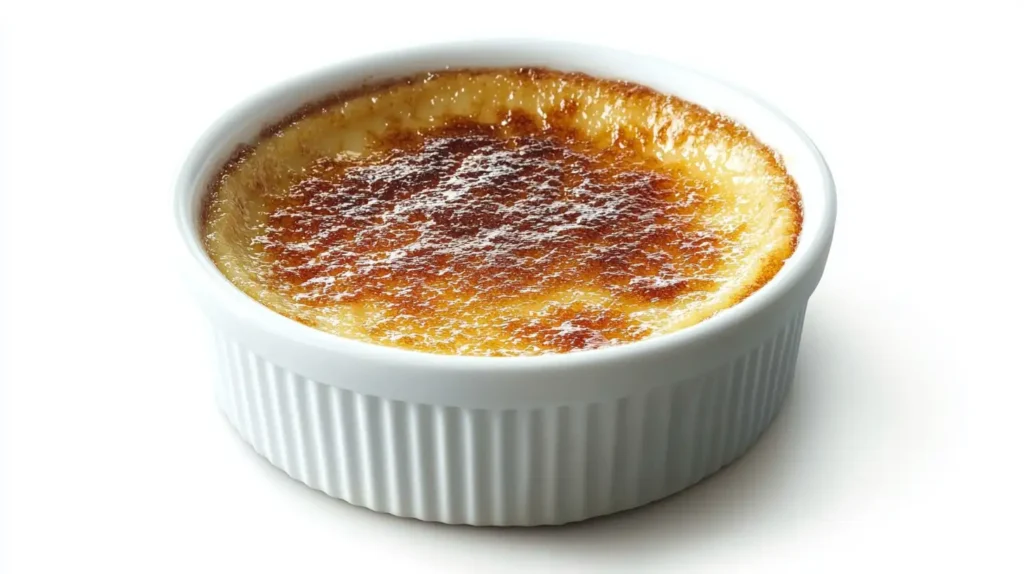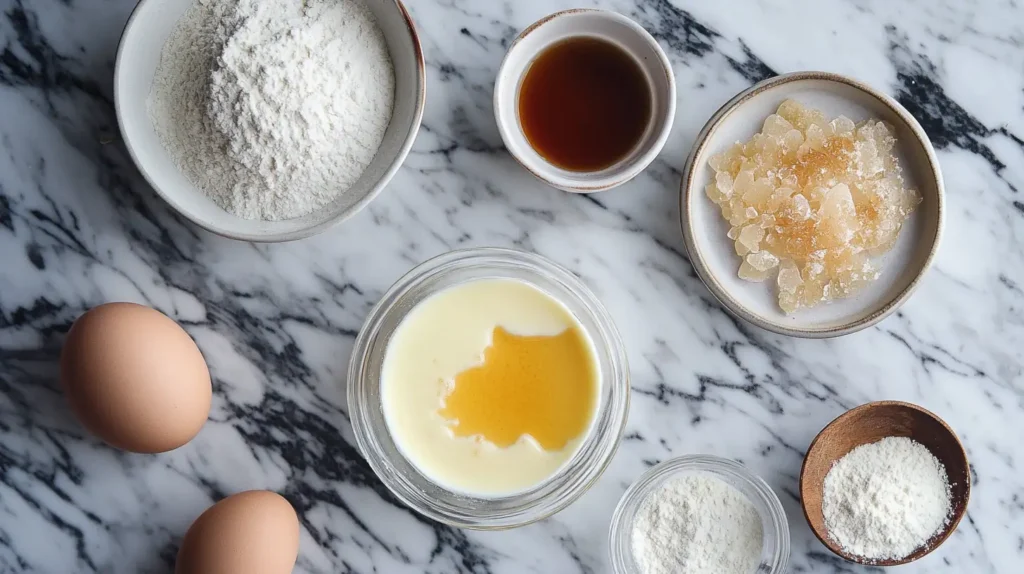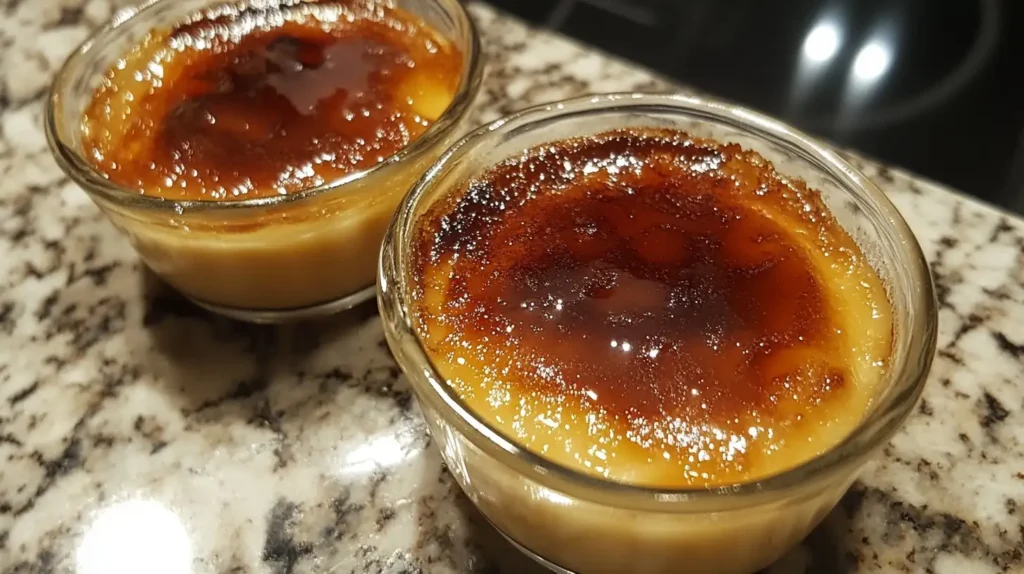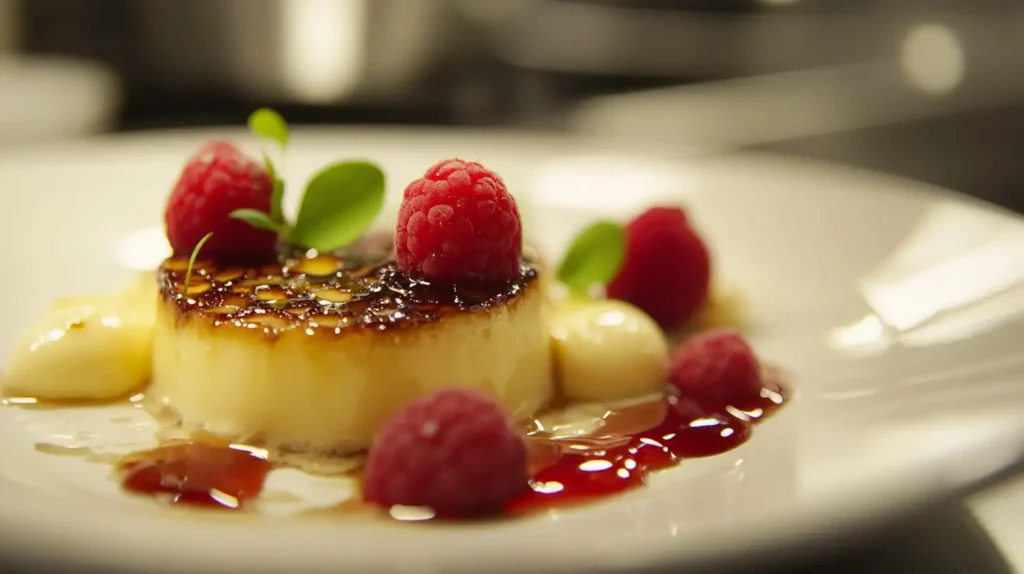Crème brûlée recipe, a dessert celebrated for its creamy custard base and caramelized sugar topping, is synonymous with sophistication and indulgence. This French classic, whose name translates to “burnt cream,” has captivated dessert enthusiasts for centuries. Its unique combination of textures and flavors makes it a standout on any menu, from casual family gatherings to upscale dining experiences.

This article takes a deep dive into every aspect of crème brûlée, including its origins, ingredients, variations, and preparation techniques. By the end, you’ll understand not only what it is made of but also why it has earned its place as a culinary masterpiece.
The Origin of Crème Brûlée Recipe
Crème brûlée’s exact origin is a subject of culinary debate. While its name is undeniably French, similar desserts appear in the histories of Spain and England. Here’s a closer look at its evolution:
- French Heritage:
In France, it has been a symbol of elegance since the 17th century. François Massialot, a French chef, first documented the recipe in his 1691 cookbook Cuisinier Royal et Bourgeois. This version featured a simple custard base topped with a thin layer of caramelized sugar. - English Burnt Cream:
England’s “burnt cream” dessert, particularly associated with Trinity College in Cambridge, predates Massialot’s recipe. Some historians argue that this dish influenced the French version. - Spanish Crema Catalana:
Spain’s “crema catalana,” often referred to as the Spanish cousin of crème brûlée, features a custard infused with citrus zest and cinnamon, topped with caramelized sugar. Unlike crème brûlée, it uses milk instead of cream.
Regardless of its exact origin, crème brûlée became a quintessential French dessert, celebrated for its simplicity and luxurious appeal.
The Science Behind Crème Brûlée
Cooking it is a balance of art and science. Its success depends on precise techniques:
Custard: The Foundation of Crème Brûlée
Custard forms through the coagulation of proteins in the egg yolks when heated. Key factors include:
- Temperature Control:
The custard must be baked gently at low temperatures to avoid curdling. A water bath, or bain-marie, ensures even heat distribution. - Texture Tips:
Strain the custard mixture through a fine sieve before pouring it into ramekins. This removes lumps and ensures a smooth finish. - Perfect Consistency:
Properly baked custard should be set around the edges but still slightly jiggly in the center.
Caramelized Sugar Layer
The caramelized topping is what sets crème brûlée recipe apart. Here’s how to perfect it:
- Blowtorch Method:
The easiest and most precise way to caramelize sugar. Hold the flame about 2 inches from the surface and move it in circles. - Broiler Alternative:
Place the ramekins under a preheated broiler, but watch closely to avoid burning. - Sugar Distribution:
Spread the sugar evenly for consistent caramelization. Too thick a layer may result in uneven melting.
The Key Ingredients
The brilliance of crème brûlée lies in its simplicity. With just a handful of ingredients, this dessert achieves a depth of flavor and texture that few others can rival.

1. The Role of Cream in Crème Brûlée recipe
Cream forms the base of the custard and is critical to its silky texture. Here’s how it contributes to the dessert:
- Richness and Texture:
Heavy cream, with its high fat content, provides a smooth, velvety texture that defines crème brûlée. This richness contrasts beautifully with the crunchy caramel topping. - Alternative Creams:
For those looking to experiment, half-and-half or even whole milk can be used. However, these alternatives result in a lighter, less indulgent custard. Non-dairy options like coconut cream or almond milk cater to dietary restrictions but introduce distinct flavors. - Tips for Using Cream:
Always use fresh cream. Avoid ultra-pasteurized cream, as it can affect the custard’s consistency. Heat the cream gently to infuse it with flavors like vanilla or spices.
2. Egg Yolks: The Binding Agent
Egg yolks are essential for creating a custard that is rich yet firm enough to hold its shape. Here’s why they matter:
Substitutions:
For vegan versions, ingredients like cornstarch or silken tofu can mimic the thickening properties of egg yolks. However, these substitutes alter the taste and texture.
Structure and Stability:
Egg yolks act as an emulsifier, binding the cream and sugar together. When heated, their proteins coagulate, creating the custard’s firm yet creamy texture.
Ratio Matters:
The number of yolks used significantly impacts the custard’s texture. Too few yolks result in a runny custard, while too many make it overly dense.
- Did You Know?: Recipes like the crab brûlée recipe sometimes use whole eggs for a firmer texture.
3. Sugar in Crème Brûlée
Sugar sweetens the custard and creates the iconic caramelized topping. Its role goes beyond flavor:
Brown Sugar: Offers a deeper flavor but can burn more easily.
Custard Sweetness:
Granulated sugar dissolves easily into the cream, ensuring a smooth custard base. Adjusting the sugar quantity allows for the personalization of sweetness levels.
Caramelization Process:
The caramelized sugar crust is achieved by sprinkling sugar over the chilled custard and applying intense heat. This process, known as the Maillard reaction, creates a layer that is crisp, golden, and slightly smoky.
Types of Sugar:
Granulated Sugar: Commonly used for the custard base.
Caster Sugar: Ideal for the topping due to its fine texture.
4. Vanilla The Classic Flavor Enhancer
Vanilla is the essence of traditional crème brûlée. It adds depth and a subtle floral sweetness to the custard.
- Types of Vanilla:
- Vanilla Beans: Preferred for their pure flavor and visual appeal (tiny black specks in the custard).
- Vanilla Extract: A convenient and widely used alternative.
- Vanilla Paste: Combines the richness of beans with the ease of extract.
- Infusing Vanilla:
Split the vanilla bean and scrape out the seeds, then heat the cream with the seeds and pod. Allow it to steep for a richer flavor.
5. Optional Additions to Crème Brûlée
Though traditional crème brûlée is flavored with vanilla, optional ingredients can elevate the dessert:
- Chocolate:
Melted chocolate mixed into the custard adds decadence. Dark chocolate pairs especially well. - Citrus Zest:
Lemon, orange, or lime zest provides a refreshing contrast to the rich custard. - Coffee or Espresso:
Incorporating espresso powder creates a mocha-inspired variation. - Spices and Herbs:
Cinnamon, nutmeg, or even lavender can infuse the dessert with unique aromas. - Liqueurs:
Add a splash of Grand Marnier, Amaretto, or Bailey’s for a sophisticated twist.
How to Prepare Crème Brûlée Recipe
Although cit may seem intimidating, the process is straightforward when broken down into steps. The secret to success lies in mastering a few key techniques.

Step 1: Making the Custard Base
- Beat the Egg Yolks and Sugar: Whisk egg yolks and sugar together until pale and creamy. This step ensures a smooth and velvety custard.
- Heat the Cream: Warm the cream gently with the vanilla. Be careful not to boil it, as overheating can scald the cream and ruin its texture.
Step 2: Tempering the Egg Mixture
Tempering is a critical step to prevent the eggs from scrambling. Slowly pour the warm cream into the egg yolk mixture while whisking constantly. This gradual combination ensures a smooth custard.
- Pro Tip: Strain the mixture through a fine mesh sieve to remove any lumps or cooked egg bits.
Step 3: Baking the Custard
Divide the custard mixture into individual ramekins. Place these in a baking dish and add hot water to the dish, creating a water bath (bain-marie). This technique ensures even cooking and prevents the custard from cracking.
- Temperature and Timing: Bake at 325°F (160°C) for 30–40 minutes, or until the custard is set but still slightly jiggly in the center.
Step 4: Chilling and Caramelizing
Allow the custards to cool to room temperature, then refrigerate for at least 4 hours. Just before serving, sprinkle sugar over the top and caramelize it using a culinary torch or broiler.
- Torch vs. Broiler: While a torch provides precise control, a broiler can be used as a substitute. However, keep a close eye to avoid burning the sugar.
For more detailed steps on mastering custards, the pumpkin banana loaf recipe offers insights into balancing sweetness and creaminess in baked goods.
Variations of Crème Brûlée Recipe
One of the reasons it remains a favorite is its versatility. Here are some popular variations to inspire your next dessert creation:
1. Flavored Crème Brûlée
- Chocolate Crème Brûlée: Add melted dark chocolate to the custard for a decadent twist.
- Coffee-Infused: Stir in brewed espresso or instant coffee for a rich, aromatic custard.
- Fruit Variations: Enhance the custard with zests of orange, lemon, or lime, or swirl in berry purées.
2. Diet-Friendly Options
- Dairy-Free: Use coconut milk or almond milk as a substitute for heavy cream. Coconut milk pairs particularly well with tropical flavors.
- Low-Sugar: Replace granulated sugar with a natural sweetener like stevia or erythritol to reduce calories without sacrificing taste.
3. Gourmet Additions
- Alcohol-Infused: Add liqueurs like Grand Marnier, Baileys, or Amaretto for an adult twist.
- Spiced Variations: Incorporate spices like nutmeg, cardamom, or star anise to create unique flavor profiles.
For inspiration on using colorful ingredients, visit this guide on cookie recipes.
Tips for Perfect Crème Brûlée
- Use Fresh Ingredients: Fresh cream, eggs, and vanilla make a significant difference in flavor.
- Invest in Ramekins: Ramekins ensures even cooking and creates a professional presentation.
- Don’t Overbake: The custard should still jiggle slightly when removed from the oven; it will firm up as it cools.
- Caramelize with Care: Use a steady hand and move the torch in circular motions to achieve a uniform golden crust.
Crème Brûlée in Modern Cuisine
It has transcended its French origins to become a global favorite, embraced by chefs and home cooks alike. Its versatility, simple elegance, and ability to pair well with a wide variety of flavors make it a centerpiece in modern culinary trends.

1. Fusion with Global Flavors
In modern cuisine, it is often reimagined with flavors from around the world. These innovations retain its creamy texture and caramelized topping while incorporating unexpected ingredients:
- Matcha Crème Brûlée: Infused with Japanese matcha powder, this variation adds an earthy bitterness to balance the sweetness.
- Thai-Inspired Crème Brûlée: Coconut milk and a hint of lemongrass or ginger give the dessert an exotic twist.
- Indian Fusion: A touch of cardamom or saffron elevates the custard with warm, aromatic notes.
2. Deconstructed Crème Brûlée
Modern plating trends have inspired chefs to deconstruct crème brûlée. Instead of serving it in traditional ramekins, the elements—custard, caramelized sugar, and garnishes—are presented separately. This creative approach showcases the components in a new, artistic light.
3. Innovative Textures and Techniques
Chefs now experiment with advanced techniques to push the boundaries of crème brûlée:
- Sous Vide Crème Brûlée: This method guarantees a perfectly smooth and evenly cooked custard by controlling temperature precisely.
- Nitrogen-Frozen Crust: Instead of using heat, some chefs use liquid nitrogen to freeze and crack the sugar crust, creating a playful twist.
4. Crème Brûlée as a Topping or Filling
Beyond its role as a standalone dessert, crème brûlée has inspired other culinary creations:
- Crème Brûlée Tarts: A custard-filled tart with a brûléed sugar top adds a crispy contrast to the flaky crust.
- Filled Donuts: Custard-filled donuts with a caramelized top combine two beloved desserts in one bite.
- Layered Cakes: Crème brûlée layers are incorporated into cakes, providing a creamy and rich surprise.
5. Health-Conscious Adaptations
As diners increasingly seek healthier options, modern chefs have adapted it to fit dietary needs:
- Vegan Crème Brûlée: Made with plant-based milk like oat or almond and thickened with agar-agar or cornstarch.
- Keto-Friendly Options: Using low-carb sweeteners such as erythritol, keto versions keep the dessert accessible to those on restrictive diets.
6. Presentation and Technology
In the digital age, presentation is as important as flavor. Instagram-worthy crème brûlée desserts now feature:
- Edible gold leaf for a luxurious touch.
- Colored sugar crusts to match themes or holidays.
- Artistic garnishes like spun sugar or floral arrangements.
The Appeal of Modern Crème Brûlée
What makes it so enduring is its ability to adapt to contemporary tastes while retaining its timeless appeal. Whether as a fusion dessert, a deconstructed masterpiece, or a health-conscious treat, it continues to captivate diners with its versatility and elegance.
Incorporating crème brûlée into your culinary repertoire opens the door to endless creativity, whether you’re a professional chef or a home cook looking to impress.
FAQs
What is crème brûlée mostly made of?
It is mostly made of four primary ingredients: heavy cream, egg yolks, sugar, and vanilla. These ingredients combine to create its signature smooth and creamy custard base, topped with a caramelized sugar crust for added texture and flavor.
What does crème brûlée literally mean?
The term crème brûlée translates to “burnt cream” in French. This name refers to the caramelized sugar layer on top of the custard, which is traditionally achieved by using a torch or broiler to “burn” the sugar until it forms a crispy crust.
Is crème brûlée the same as egg custard?
While crème brûlée and egg custard share similarities, they are not the same. Both are custard-based desserts made with eggs, cream, and sugar, but crème brûlée features a caramelized sugar topping that egg custard lacks. Additionally, It is typically richer due to its use of heavy cream and the emphasis on a silky-smooth texture.
Is crème brûlée served hot or cold?
It is traditionally served cold. The custard is chilled after baking to allow it to set, and the caramelized sugar topping is added just before serving. The contrast between the cold custard and the slightly warm, freshly caramelized sugar crust adds to its appeal.
Nutritional Breakdown
Crème brûlée is a rich dessert, and its nutritional profile reflects its indulgent nature. A typical serving contains:
- Calories: 300–400
- Fat: 25–30 grams
- Carbohydrates: 20–30 grams
- Protein: 4–6 grams
For those looking to balance health and indulgence, smaller portion sizes or low-sugar options can help reduce caloric intake.
Conclusion
Crème brûlée’s timeless appeal lies in its simplicity, versatility, and elegance. Whether you stick to the classic vanilla custard or experiment with creative flavors, this dessert is sure to delight. With the right techniques and high-quality ingredients, you can master crème brûlée at home.
For more recipes and ideas, explore TripsRecipes to expand your dessert repertoire and try new culinary adventures.

